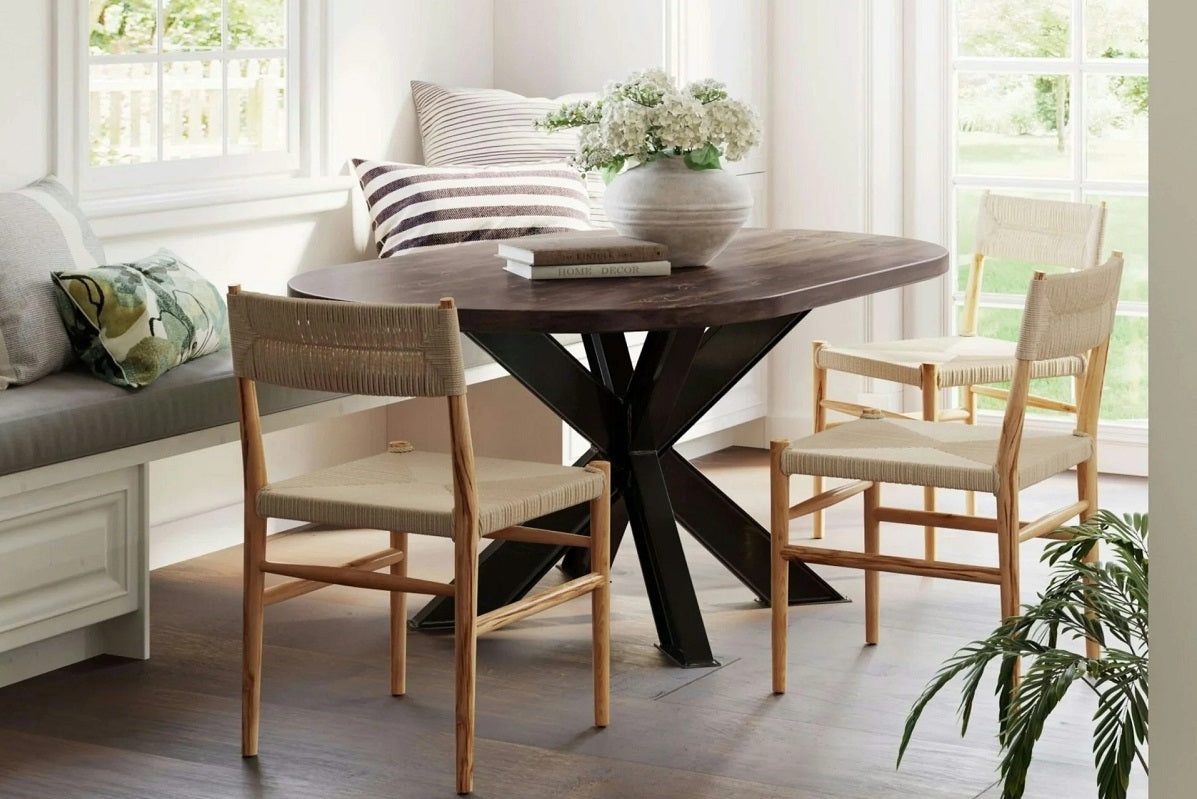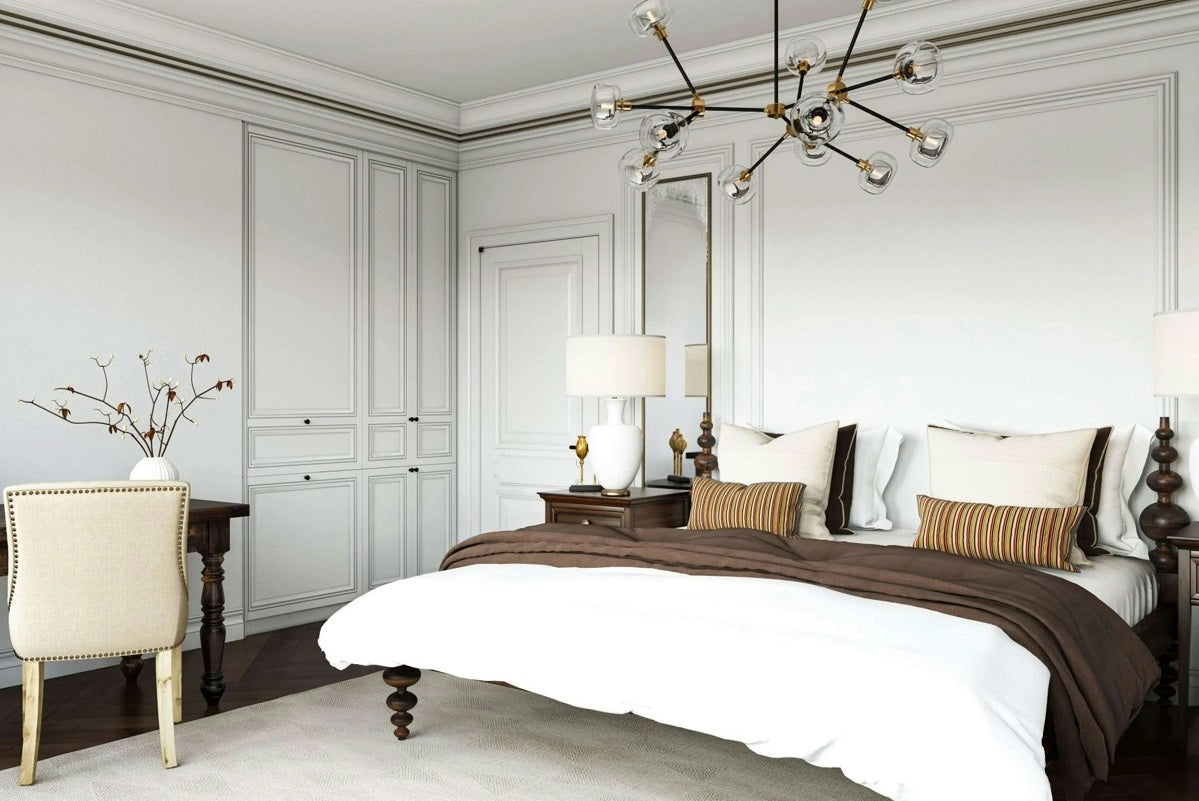How to Choose Dining Room Chairs: 6 Tips

Dining rooms have an interesting history. Long before his presidency, Thomas Jefferson created a room just for dining—an unusual feature in late-1700s American homes.1 Over time, the concept caught on, and today, dining rooms are the heart of many homes, serving as spaces for everything from casual nightly meals to festive family gatherings.
But whether it’s a quiet dinner or a lively celebration, one thing is constant—everyone needs a seat. That’s where dining room chairs come in.
Choosing the right dining room chairs can elevate both the look and functionality of your space. With thoughtful interior design, you can turn your dining area into a truly inviting hub. And don’t forget the role of your tabletop—pairing the perfect chairs with your dining table can complete the overall aesthetic. In this guide, we’ll break it all down, covering everything from different styles to material options, so you can confidently find the perfect fit for your dining table and lifestyle.
Assess Your Dining Table and Space
Start with the basics: How much room do you have? How much room can you create? Your dining table and the size of your space will dictate the type and number of chairs that work best.
Standard Table Dimensions
Before choosing chairs, you’ll need to know your table’s dimensions. A standard dining table height is typically 28–30 inches, but other measurements vary depending on the table’s shape and size. Here’s a quick breakdown of common table dimensions for tables that seat four:
-
Round tables: 36–44 inches in diameter
-
Oval tables: 36 inches in diameter by 56 inches long
-
Square tables: 36–44 inches squared
-
Rectangular tables: 36 inches wide by 48 inches long
Knowing your table’s size helps you choose chairs that fit comfortably without crowding your space.
Chair Width
Dining chairs typically have a seat width of 16.5–22 inches. This width ensures enough room for diners to sit comfortably without feeling cramped, while also leaving adequate space between chairs for elbow room.
Room Size
It’s also essential to think about your overall dining room size. Guests need enough room to pull chairs out, walk around the table, and move comfortably—even if someone likes to lean back on their chair (we all know one of those!). Precise measurements and creative arrangements can make even small dining areas feel spacious and inviting.
Determine Chair Style
Dining room chairs aren’t just functional—they’re a chance to reflect your personal style and enhance the atmosphere of your dining space. From armchairs to sleek modern designs, there’s a chair for every aesthetic and need.
Armchairs vs Armless Chairs
The choice between armchairs and armless chairs often comes down to preference, space, and intended use.
Perks of armchairs:
-
They’re versatile, elegant, and ergonomic because of the armrests.
-
Great for kids or older adults who need extra support.
-
They can double as statement pieces for formal settings.
Drawbacks of armchairs:
-
They require more space—up to 7 extra inches per chair.
-
They can feel less inviting in casual settings.
-
They’re heavier and harder to move around.
Advantages of armless chairs:
-
They’re flexible, functional, and space-saving.
-
They allow you to fit more people around the table.
-
Their open design encourages sociability and engagement.
Potential downsides of armless chairs:
-
Guests might rest their hands on the table, which can look less polished.
-
They may lack the formal appeal of armchairs for high-end settings.
When deciding, consider the overall vibe you want to create. Armchairs add a sense of sophistication, while armless chairs keep things casual and versatile.
Back Height & Style
Dining chair back height typically ranges from 32–34 inches, though chair height can vary depending on the look you’re going for. Here are three main categories:
-
Low backs: These chairs sit at seat height and are perfect for minimalist, modern designs, blending seamlessly with a dining room table or bar stool setup.
-
Standard backs: The most traditional option, these range from 32–34 inches in chair height and work well in almost any setting, complementing most dining room table styles.
-
Tall backs: These chairs make a bold statement with their seat height and design. Think of Frank Lloyd Wright’s iconic high-backed Robie chairs for inspiration.
Chair backs also come in various styles, including open, slatted, or solid designs. Open backs feel airy and modern, slatted backs add texture, and solid backs bring a sense of structure and formality to your dining room table setting or bar stool arrangement.

Choose Materials and Upholstery
Wood, metal, and upholstery are the most common dining chair materials. Let’s take a seat and compare.
Wood
Wood is a classic choice for a reason. It’s durable, versatile, and timeless. You can customize wood chairs with different stains or finishes to fit your style, and they’re generally easy to clean. The only downside? They can be heavy, though this is rarely a major issue given their reliability.
Metal
Metal chairs tend to be lighter and easier to move around. They’re also low-maintenance and perfect for industrial or modern designs. However, metal chairs can be less comfortable and cold to the touch in chilly weather.
Upholstered
For maximum comfort and style, upholstered chairs are the way to go. They come in an endless array of colors, patterns, and textures, making them easy to personalize. The trade-off is that they require more upkeep and don’t last as long as wood or metal chairs.
Consider Comfort and Ergonomics
Comfort is key when you’re picking chairs you’ll use every day. Here’s what to keep in mind:
Seat Depth and Width
A typical dining chair seat width ranges from 16.5–22 inches, while seat depth (the distance between the backrest and seat edge) is usually 20–24 inches. Both dimensions should allow most people to sit comfortably without feeling cramped or unsupported.
Back Support
Good back support can make a huge difference, especially for longer meals. Ask yourself:
-
Is the chair stable and sturdy?
-
Does your family need taller backs for extra support?
-
Are there ergonomic features like lumbar support or padding?
Mix and Match Thoughtfully
You don’t have to stick to identical chairs for a cohesive dining room. Mixing and matching can add personality and charm. For example:
-
Use the same chair in different colors or patterns.
-
Pair modern and vintage designs for contrast.
-
Add a bench for a casual, communal vibe.

Discover Solid Wood Dining Chairs from James & James
At James & James, we believe dining rooms are more than just spaces to eat—they’re spaces to connect, celebrate, and host unforgettable dinner parties. Our high-quality, American-made, solid wood dining chairs are crafted to complement any dining room furniture and create a cohesive look. Explore our variety of wooden chair styles, finishes, and price points to find the perfect fit for your home. Personalize your dining room furniture with James & James today!




0 comments
Add a comment